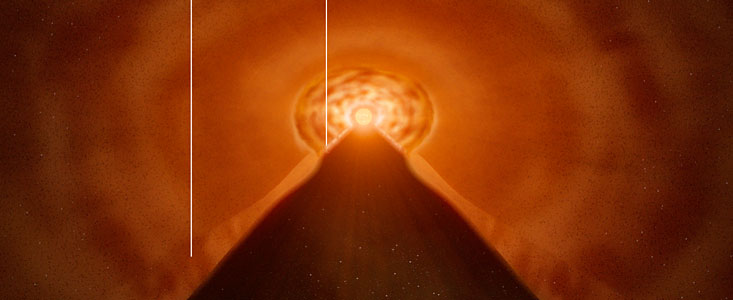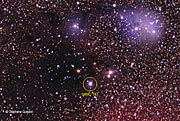Tisková zpráva
Dospívající hvězda
VLT odhalil bezprostřední okolí dospívající hvězdy
29. ledna 2008
S pomocí interferometru na VLT se astronomům podařilo zachytit vnitřní oblasti disku hmoty okolo mladé hvězdy. Disk ukazuje, jak hvězda během svého dětství přibírá na hmotnosti.
Astronomové podrobně zkoumali objekt označený jako MWC 147, který leží přibližně 2600 světelných let od Slunce v souhvězdí Monoceros (Jednorožec). MWC 147 náleží do skupiny Herbig Ae/Be, tzn. že se jedná o hvězdy několikrát hmotnější než Slunce, jež díky pohlcování materiálu z okolí neustále přibírají na hmotnosti.
MWC 147 je hvězda stará necelého půl miliónu let a srovnáme-li tento věk se stářím našeho Slunce, které má nyní 4,6 miliardy let, jedná se vlastně o jednodenní mimino [1].
Stefan Kraus, Thomas Preibisch a Keiichi Ohnaka použili sestavu čtyř 8,2 metrových dalekohledů VLT a k pozorování využili světlo ze dvou až tří těchto dalekohledů, napojených na přístroje MIDI a AMBER.
„Při pozorování MWC 174 pomocí VLTI/MIDI a VLTI/AMBER jsme zkombinovali snímky z blízké a střední infračervené oblasti. Poprvé jsme změřili velikost disku okolo hvězdy v takto velkém rozsahu vlnových délek [2],“ řekl Stefan Kraus, šéfredaktor publikovaných studií. „Různé vlnové délky odpovídají různým teplotám a umožňují nám poodhalit tvar disku ve větším měřítku. Na druhou stranu nám ale komplikují určení, jak se mění teplota v závislosti na vzdálenosti od hvězdy.“
ESO Press Release 03/08Blízká infračervená oblast odhalila až několik tisíc stupňů horký materiál v nejbližším okolí hvězdy, zatímco střední infračervená oblast ukázala dále od středu disku oblasti chladnější.
Pozorování ukázala, že teplota v závislosti na vzdálenosti od hvězdy klesá mnohem prudčeji, než předpokládají současné modely. Většina blízkého infračerveného světla pochází z horkého materiálu ve vzdálenosti menší než 1-2 AU (1 AU = střední vzdálenost Země od Slunce). Z důvodu silného záření však v takovéto vzdálenosti od hvězdy nemůže existovat, neboť by se zahřál a zničil.
„Abychom zcela porozuměli našim pozorováním, provedli jsme podrobné výpočty a dospěli k závěru, že jsme jednak pozorovali vnější prachový disk, ale také silnou emisi pocházející z horkého plynu ve vnitřním disku,“ vysvětluje Kraus. „Disk okolo hvězdy nepovažujeme za pasivní, ale za aktivní a my tak pozorujeme hmotu, která přechází z vnějšího disku ke vznikající hvězdě.“
Model, který nejlépe odpovídá pozorování, předpokládá, že se disk rozprostírá do vzdálenosti 100 AU od svého středu. Hvězda v centru disku nabírá hmotnost rychlostí sedmi miliontin hmotnosti Slunce za rok.
„Naše pozorování ukazuje sílu VLT při zkoumání vnitřní struktury disků mladých hvězd a odhaluje, jak hvězdy dosahují svých konečných hmotností,“ říká Stefan Kraus.
Poznámky
[1] Being 6.6 times more massive than the Sun, however, MWC 147 will only live for about 35 million years, or to draw again the comparison with a person, about 100 days, instead of the 80 year equivalent of our Sun.
[2] MIDI is the mid-infrared instrument of the VLT interferometer. It operates between 8 and 13 microns. AMBER observes in the near-infrared, from 1 to 2.4 microns.
Další informace
The authors report their results in a paper in the Astrophysical Journal ("Detection of an inner gaseous component in a Herbig Be star accretion disk: Near- and mid-infrared spectro-interferometry and radiative transfer modeling of MWC 147", by Stefan Kraus, Thomas Preibisch, Keichii Ohnaka").
Kontakty
Stefan Kraus
Max-Planck-Institute for Radio Astronomy
Bonn, Germany
Tel.: +49 (0)228 525-395
Email: skraus@mpifr-bonn.mpg.de
Anežka Srbljanović (press contact Česko)
ESO Science Outreach Network
a Astronomical Institute of Czech Academy of Sciences
Tel.: +420 323 620 116
Email: eson-czech@eso.org
O zprávě
| Tiskové zpráva č.: | eso0803cs |
| Legacy ID: | PR 03/08 |
| Jméno: | MWC 147 |
| Typ: | Milky Way : Star : Evolutionary Stage : Young Stellar Object |
| Facility: | Very Large Telescope, Very Large Telescope Interferometer |
| Instruments: | AMBER, MIDI |
| Science data: | 2008ApJ...676..490K |
Our use of Cookies
We use cookies that are essential for accessing our websites and using our services. We also use cookies to analyse, measure and improve our websites’ performance, to enable content sharing via social media and to display media content hosted on third-party platforms.
ESO Cookies Policy
The European Organisation for Astronomical Research in the Southern Hemisphere (ESO) is the pre-eminent intergovernmental science and technology organisation in astronomy. It carries out an ambitious programme focused on the design, construction and operation of powerful ground-based observing facilities for astronomy.
This Cookies Policy is intended to provide clarity by outlining the cookies used on the ESO public websites, their functions, the options you have for controlling them, and the ways you can contact us for additional details.
What are cookies?
Cookies are small pieces of data stored on your device by websites you visit. They serve various purposes, such as remembering login credentials and preferences and enhance your browsing experience.
Categories of cookies we use
Essential cookies (always active): These cookies are strictly necessary for the proper functioning of our website. Without these cookies, the website cannot operate correctly, and certain services, such as logging in or accessing secure areas, may not be available; because they are essential for the website’s operation, they cannot be disabled.
Functional Cookies: These cookies enhance your browsing experience by enabling additional features and personalization, such as remembering your preferences and settings. While not strictly necessary for the website to function, they improve usability and convenience; these cookies are only placed if you provide your consent.
Analytics cookies: These cookies collect information about how visitors interact with our website, such as which pages are visited most often and how users navigate the site. This data helps us improve website performance, optimize content, and enhance the user experience; these cookies are only placed if you provide your consent. We use the following analytics cookies.
Matomo Cookies:
This website uses Matomo (formerly Piwik), an open source software which enables the statistical analysis of website visits. Matomo uses cookies (text files) which are saved on your computer and which allow us to analyze how you use our website. The website user information generated by the cookies will only be saved on the servers of our IT Department. We use this information to analyze www.eso.org visits and to prepare reports on website activities. These data will not be disclosed to third parties.
On behalf of ESO, Matomo will use this information for the purpose of evaluating your use of the website, compiling reports on website activity and providing other services relating to website activity and internet usage.
Matomo cookies settings:
Additional Third-party cookies on ESO websites: some of our pages display content from external providers, e.g. YouTube.
Such third-party services are outside of ESO control and may, at any time, change their terms of service, use of cookies, etc.
YouTube: Some videos on the ESO website are embedded from ESO’s official YouTube channel. We have enabled YouTube’s privacy-enhanced mode, meaning that no cookies are set unless the user actively clicks on the video to play it. Additionally, in this mode, YouTube does not store any personally identifiable cookie data for embedded video playbacks. For more details, please refer to YouTube’s embedding videos information page.
Cookies can also be classified based on the following elements.
Regarding the domain, there are:
- First-party cookies, set by the website you are currently visiting. They are stored by the same domain that you are browsing and are used to enhance your experience on that site;
- Third-party cookies, set by a domain other than the one you are currently visiting.
As for their duration, cookies can be:
- Browser-session cookies, which are deleted when the user closes the browser;
- Stored cookies, which stay on the user's device for a predetermined period of time.
How to manage cookies
Cookie settings: You can modify your cookie choices for the ESO webpages at any time by clicking on the link Cookie settings at the bottom of any page.
In your browser: If you wish to delete cookies or instruct your browser to delete or block cookies by default, please visit the help pages of your browser:
Please be aware that if you delete or decline cookies, certain functionalities of our website may be not be available and your browsing experience may be affected.
You can set most browsers to prevent any cookies being placed on your device, but you may then have to manually adjust some preferences every time you visit a site/page. And some services and functionalities may not work properly at all (e.g. profile logging-in, shop check out).
Updates to the ESO Cookies Policy
The ESO Cookies Policy may be subject to future updates, which will be made available on this page.
Additional information
For any queries related to cookies, please contact: pdprATesoDOTorg.
As ESO public webpages are managed by our Department of Communication, your questions will be dealt with the support of the said Department.



